
Gold and silver coins of the Roman Empire had been minted over many centuries. The Roman Empire was one of the most powerful ancient states. It occupied the territory of almost all Europe, a part of Africa and even Asia, but a strong army was not enough to subjugate all these territories. This became the prerequisite for creating a powerful financial system, which was based on the minting of gold and silver coins. Some types of coins due to monetary reforms and a change in the reign of emperors were replaced by others, but the most stable were gold aurei and silver denarii. Each subsequent emperor of the Roman Empire minted his portrait on the obverse, and on the reverse it was customary to depict symbols of power and images of Roman mythology.
Gold coins of the Roman Empire
- Coinage of Augustus Octavian: aurei of the period from 43 BC to 2 AD
- Coinage of Didius Julianus: aurei of 193
- Coinage of Lucius Vera (Lucius Aurelius Commodus): aurei of 163-169
- Chasing of Caligula: aurei of 37-41
- Coinage of Vespasian: aurei of 69-79
- Coinage of Hadrianus: aurei of 117-138, Quinariy 134-138
- Coinage of Domitianus: aurei of 81-96
- Coinage of Galba: aurei of 68-69
- Coinage of Marcus Salvius Otho: aurei of 69
- Coinage of Marcus Aurelius: aurei of 161-180
- Coinage of Gaius Pescennius Niger Iustus: aurei of 193-194
- Coinage of Marcus Aurelius Probus: aurei of 278
- Coinage of Tiberius: aurei of 14-37
- Coinage of Nero: aurei of 54-67
- Coinage of Claudius: aurei of 41-54
- Coinage of Lucius Septimius Severus: aurei of 193–207
- Coinage of Marcus Ulpius Nerva Traianus: aurei of 100-117
- Coinage of Titus: aurei of 73-80
- Coinage of Marcus Antonius Gordianus: aurei of 238-243
- Coinage of Titus Antoninus: aurei of 140-161, Quinarium 152-153
- Coinage of Lucius Aelius Aurelius Commodus: aurei of 180-192
- Coinage of Aulus Vitellius: aurei 69
- Coinage of Publius Helvius Pertinax: aurei 193
- Coinage of Marcus Cocceius Nerva: aurei 97
- Coinage of Constantine: solidus 309-324










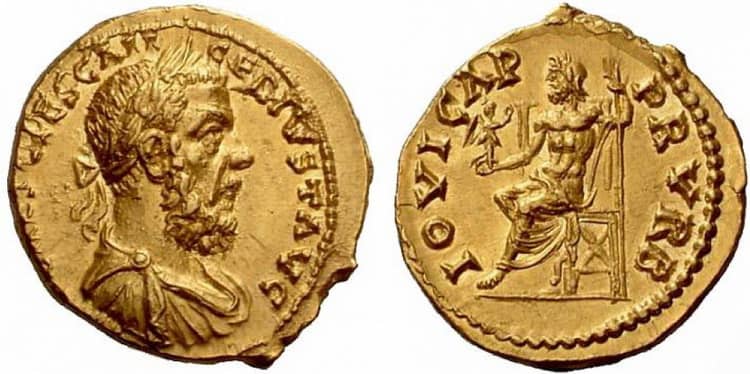

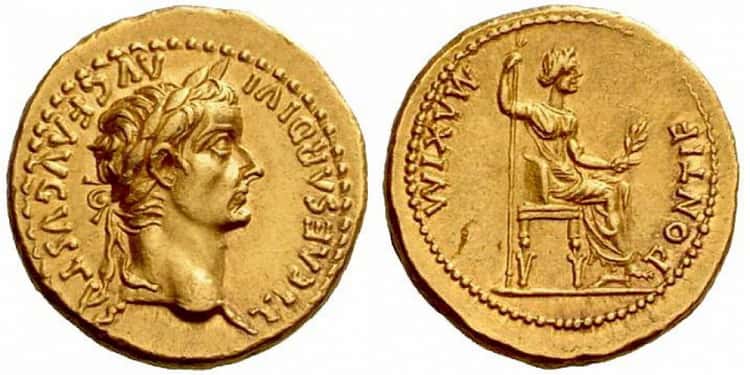



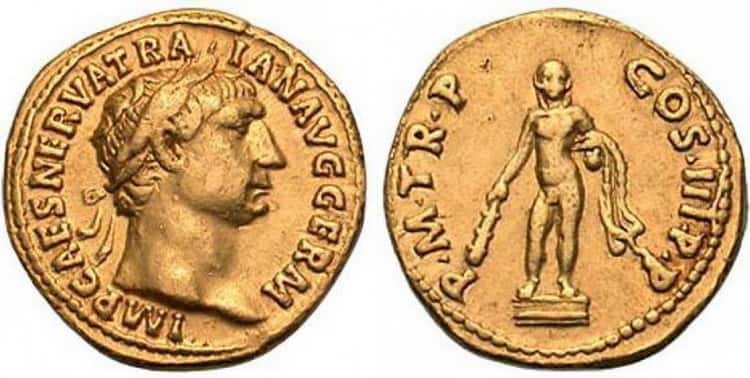



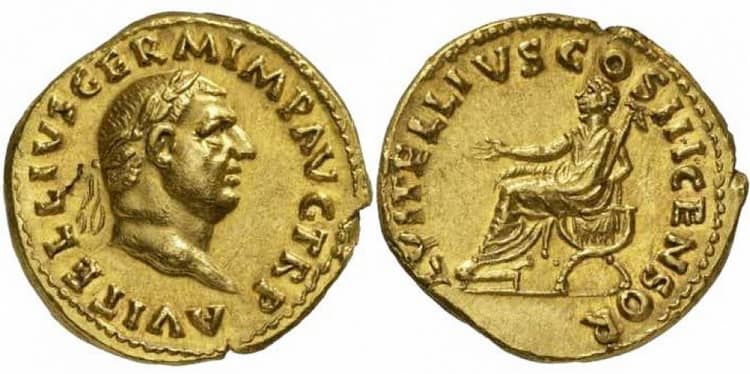


Did you know? Gold aureus or in plural aureii were minted for the convenience of making major transactions both within the empire and with other states. In addition, they were used to award soldiers after heroic battles in the name of the Empire. The weight of aureus is 4.45 g, and its diameter is 22 mm.
Silver coins of the Roman Empire
- Coinage of Octavianus Augustus: denarius of the period from 32 BC to 13-14 AD, Kristoff coinage of 27-18 BC, Quintarius coinage of 25-23 BC, Tetradrachm coinage of 16 BC.
- Coinage of Didius Julianus: denarii of 193
- Coinage of Lucius Vera (Lucius Aurelius Commodus): denarii of 161-168
- Coinage of Caligula: denarii of 37-41, Drachma, 37-38, didrachma of 37-38
- Coinage of Vespasian: denarii of 69-79, didrachma of 76-77
- Coinage of Hadrianus: denarii of 117-139, Tetradrachm of 129-138
- Coinage of Domitianus: denarii of 82-91
- Coinage of Galba: denarii of 68-69 biennium., Tetradrachm of 68-69
- Coinage of Marcus Salvius Otho: denarii of 69
- Coinage of Pupienus and Balbinus: denarii of 238
- Coinage of Marcus Aurelius: denarii of 161-173
- Coinage of Gaius Pescennius Niger Iustus: denarii of 193-194
- Coinage of Septimius Bassianus Caracalla: denarii of 196-212
- Coinage of Decius Caelius Calvinus Balbinus: denarii of 238
- Coinage of TiberiusIulius Caesar Nero: denarii of the period from 41 BС to 37 AD, Tetradrachm of 27-28, Drachma 33-34
- Coinage of Gaius Messius Quintus Traianus Decius: antonian 250-251
- Coinage of Nerō Claudius Caesar Augustus Germanicus: Tetradrachm 61-63, denarii of 64-66
- Coinage of Claudius: Kristoff of 41-51, denarii of 41-54
- Coinage of Marcus Ulpius Nerva Traianus: denarii of 98-117
- Coinage of Titus: denarii of 79-81
- Coinage of Lucius Clodius Macer: denarii of 68
- Coinage of Gordianus III: antonian of 238-243
- Coinage of Anthonius Pius: denarii of 138-161, didrachma, 139
- Coinage of Commodus: denarii of 180-182
- Coinage of Vitellius: denarii of 69 g
- Coinage of Publius Helvius Pertinax: denarii of 193
- Coinage of Marcus Cocceius Nerva: denarii of 96-98







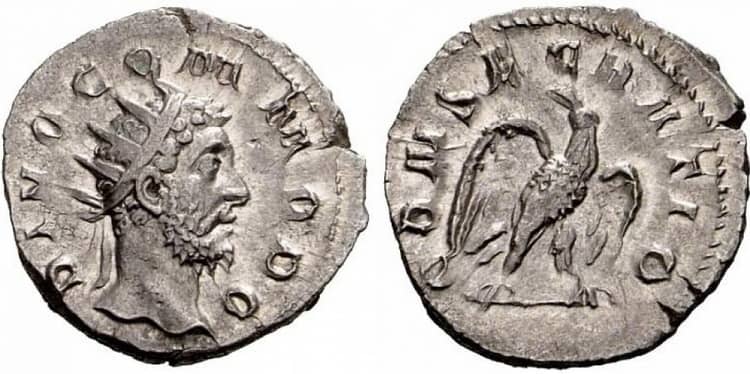
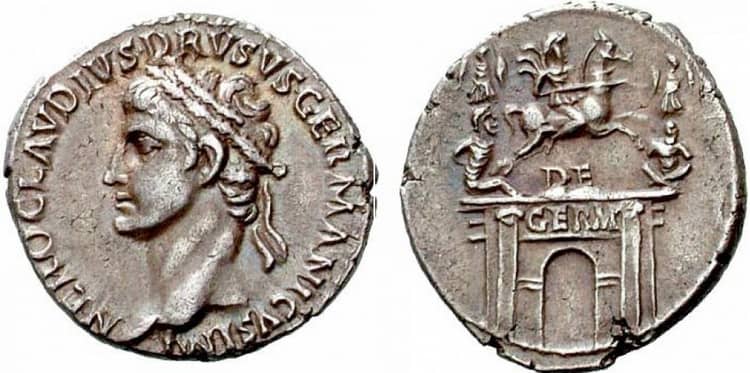
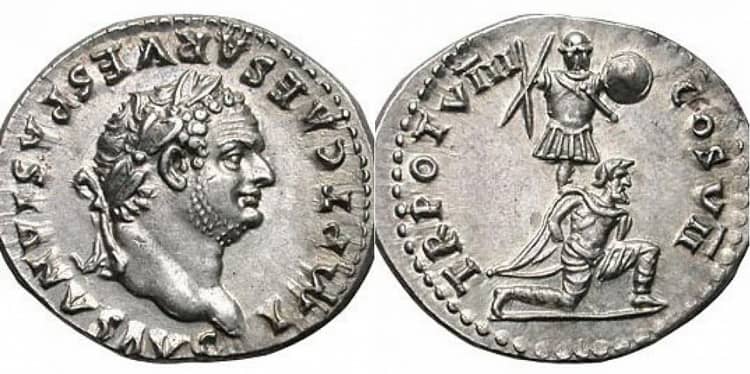
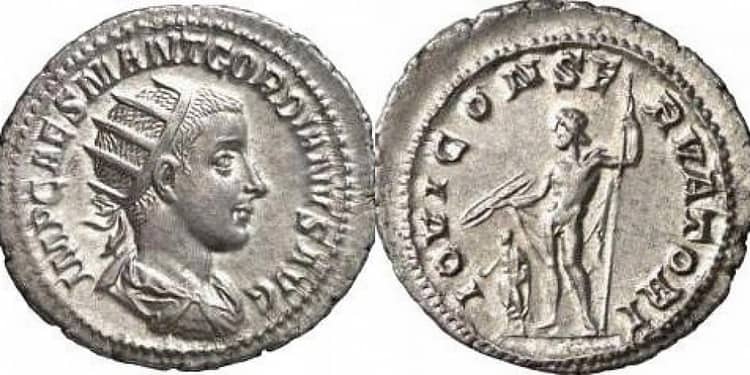

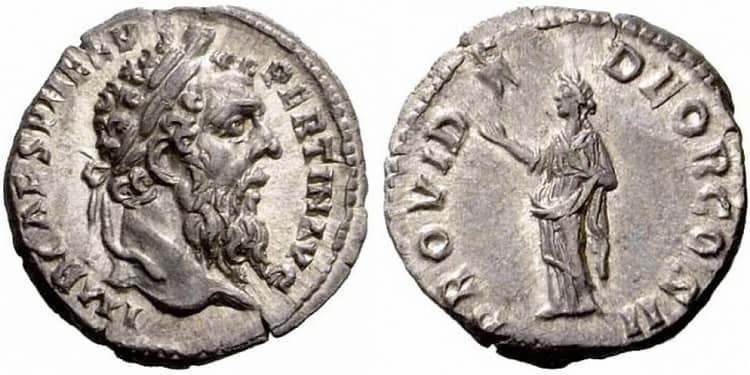
Silver coins of the Holy Roman Empire
During the period of the Holy Roman Empire, only the emperor had the right to mint coins, but he could transfer this right to one of his vassals. For example, from 1220 to 1250 under the rule of Frederick II, the right to coinage was granted to spiritual and secular feudal lords, but only in territories under their control. Subsequently, in 1356 this right was officially approved by the Golden Bull law, but this led to the emergence of numerous coin systems and, as a result, to economic crises. Centralized attempts to create a single standard of monetary circulation were undertaken only in the 16th century, when the corresponding social and political prerequisites appeared for the minting of a new type of coins:
- Coinage of Maximilian I (1508-1519): 2 kreuzers of 1513
- Coinage of Charles V (1519-1556): 1 pfennig of 1520
- Coinage of Ferdinand I (1556-1564): 2 kreuzers of 1562
- Coinage of Maximilian II (1564-1576): 2 kreuzers of 157
- Coinage of Ferdinand II (1619-1637): 1 thaler of 1621, 3 kreuzers of 1627-1637, 1 kreuzer of 1625, 2 pfennigs of 1625
- Coinage of Ferdinand III (1637-1657): 3 kreuzers of 1624-1638.
- Coinage of Leopold I (1657-1705): 15 kreuzers of 1660-1696, 6 kreuzers of 1683, 3 kreuzers of 1670-1697, 3 pfennigs of 1697, 2 pfennigs of 1662-1689
- Chasing of Charles VI (1711-1740): 15 kreuzers of 1739
- Chasing of Franz I and Maria Theresa (1745-1765): 20 kreuzers of 1765
- Chasing of Joseph II and Maria Theresa (1765-1780): 20 kreuzers of 1775
- Chasing of Joseph II (1780-1790): 20 kreuzers of 1783
- Chasing of Franz II (1792-1806): 20 kreuzers of 1803, 7 kreuzers of 1802







The cost of such coins on the market
You can buy any coin from the period of the Roman Empire on numismatic auctions or exchanges, focusing on prices in online catalogs. The tables show the approximate value of some gold and silver coins from different periods of minting.
Silver coins of the Roman Empire
|
Name of the coin |
Year of issue |
Price ($ USD) |
|
denaruis Octavianus Augustus |
29-27 BC |
918-1 551 |
|
denaruis Didius Julianus |
193 |
5 393-5 186 |
|
denaruis Lucius Aurelius |
161-162 |
81-162 |
|
denaruis Caligula |
37-38 |
5 274-12 055 |
|
drachma Caligula |
37-38 |
695 |
|
denaruis Vespasian |
69-70 |
450 |
|
denaruis Hadrianus |
117-138 |
200 |
|
denaruis Domitianus |
82-83 |
9 180 |
|
denaruis Galba |
68 |
5 600 |
|
tetradrachm Galba |
68-69 |
918 |
|
denaruis Marcus Salvius Otho |
69 |
2 295 |
|
denaruis Pupienus and Balbinus |
238 |
425-500 |
|
denaruis Marcus Aurelius |
161 |
150-203 |
|
denaruis Gaius Pescennius Niger Iustus |
193-194 |
3 319-4 771 |
|
denaruis Septimius Bassianus Caracalla |
196 |
45 |
|
denaruis Decius Caelius Calvinus Balbinus |
238 |
2 000-2 200 |
|
denaruis Tiberius Iulius Caesar Nero |
41 BC |
2 800-3 000 |
|
antonian Gaius Messius Quintus Traianus Decius |
250-251 |
388-504 |
|
tetradrachm Nerō Claudius Caesar Augustus Germanicus |
63 |
525 |
|
denaruis Nerō Claudius Caesar Augustus Germanicus |
64-65 |
1 939 |
|
krostoff Claudius |
41-42 |
5 000-7 250 |
|
denaruis Marcus Ulpius Nerva Traianus |
98-117 |
6 120 |
|
denaruis Claudius |
41-45 |
11 617-16 595 |
|
denaruis Titus |
79-80 |
1 912 |
|
denaruis Lucius Clodius Macer |
68 |
14 935-24 892 |
|
antonian Gordianus III |
238-239 |
105-117 |
|
denaruis Anthonius Pius |
138 |
125 |
|
didrachma Anthonius Pius |
139 |
526 |
|
denaruis Commodus |
180-182 |
240-365 |
|
denaruis Vitellius |
69 |
1 913 |
|
denaruis Publius Helvius Pertinax |
193 |
2 327-2 637 |
|
denaruis Marcus Cocceius Nerva |
96 |
403 |
Gold coins of the Roman Empire
|
Name of the coin |
Year of issue |
Price ($ USD) |
|
aureus Augustus Octavian |
42 BC |
63 558 |
|
aureus Didius Julianus |
193 |
31 020-24 816 |
|
aureus Lucius Aurelius |
163-164 |
7 650 |
|
aureus Caligula |
37-38 |
70 000-120 000 |
|
aureus Vespasian |
69-70 |
4 973 |
|
aureus Hadrianus |
117-118 |
15 510 |
|
aureus Domitianus |
81-83 |
3 825 |
|
aureus Galba |
68-69 |
181 818-413 223 |
|
aureus Marcus Salvius Otho |
69 |
16 530-41 325 |
|
aureus Marcus Aurelius |
161-176 |
6 392 |
|
aureus Gaius Pescennius Niger Iustus |
193-194 |
148 761-190 083 |
|
aureus Marcus Aurelius Probus |
278 |
5 000-22 000 |
|
aureus Tiberius |
14-16 |
8 154-11 552 |
|
aureus Nero |
54 |
15 300 |
|
aureus Claudius |
41-45 |
19 749-23 041 |
|
aureus Lucius Septimius Severus |
193-194 |
4 682-10 144 |
|
aureus Marcus Ulpius Nerva Traianus |
100 |
2 650 |
|
aureus Titus |
73 |
3 511 |
|
aureus Marcus Antonius Gordianus III |
238-239 |
3 223-3 719 |
|
aureus Titus Antoninus |
140 |
8 265-10 744 |
|
aureus Lucius Aelius Aurelius Commodus |
180-182 |
9 364-14 045 |
|
aureus Aulus Vitellius |
69 |
33 320-91 628 |
|
aureus Publius Helvius Pertinax |
193 |
19 500 |
|
aureus Marcus Cocceius Nerva |
97 |
13 223-22 314 |
Interesting Facts
- Copper coins of the Roman Empire were minted along with silver denarii and gold aureus. In different years of this period, copper was minted from sestertius, assarius, dupondius, quadrans, Aurelius antonians, follis.
- After the next monetary reform, the gold aureus of the Roman Empire was replaced by coins: the soldier of Constantine and the soldiers of St. Valentine. It goes without saying that a solidus of the Roman Empire subsequently inherited Byzantium.
- The Emperor of the Holy Roman Empire, Maximilian I, in 1513 began to produce the kreuzers – a new type of silver coins.
- Marcus Cocceius Nerva was a Roman emperor since 96 AD. Nerva ruled in tandem with the Senate and thanks to the economy was able to restore the state treasury. He distributed land to ordinary citizens and established a maintenance fund for needy children. In the year 97, Nerva adopted Marcus Ulpius Nerva Traianus, who later became his co-ruler and heir to the throne.
Comments
No commens yet.